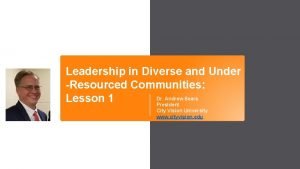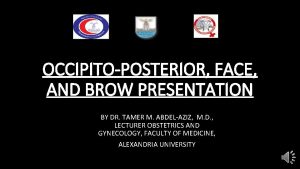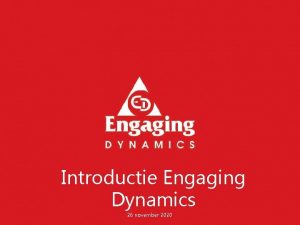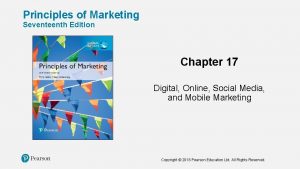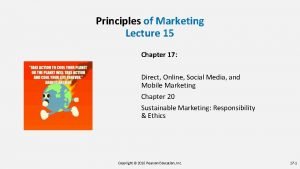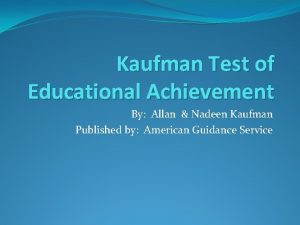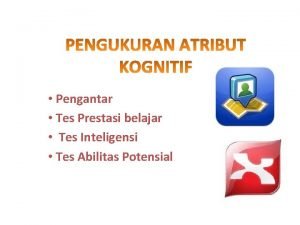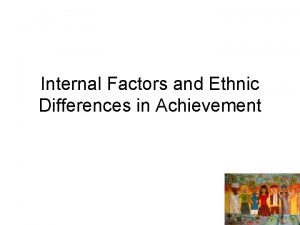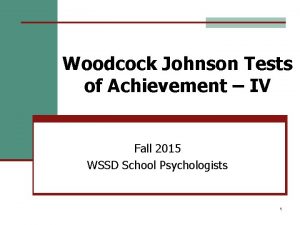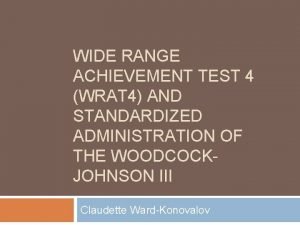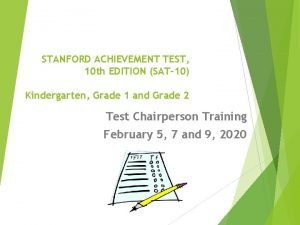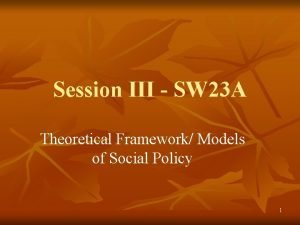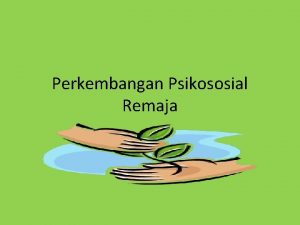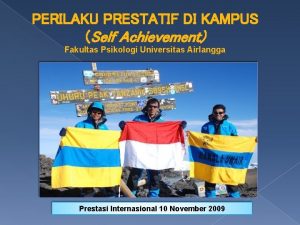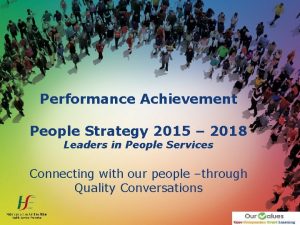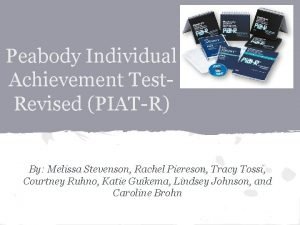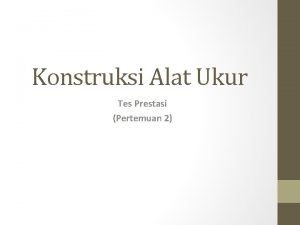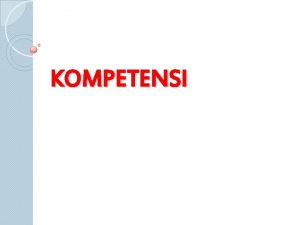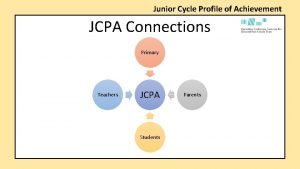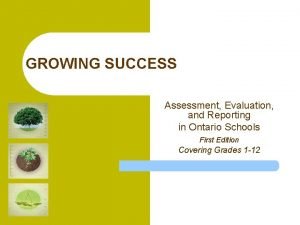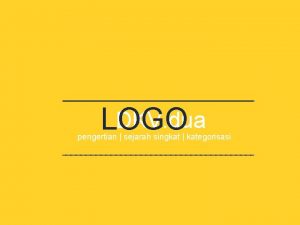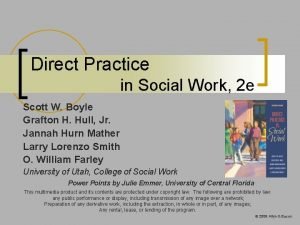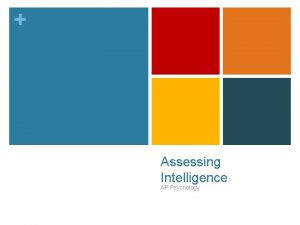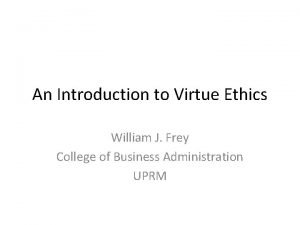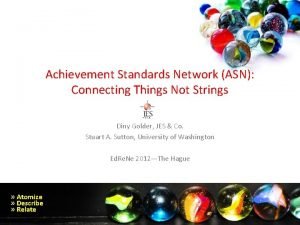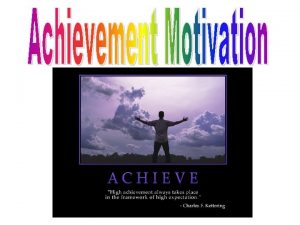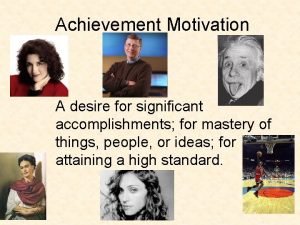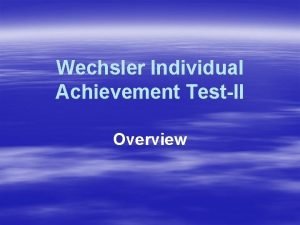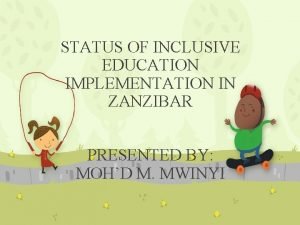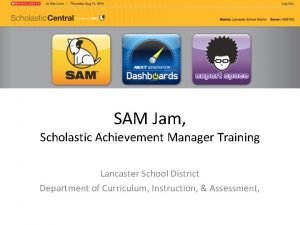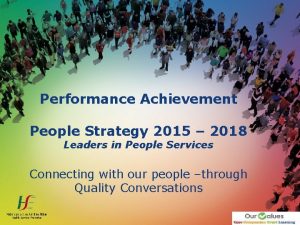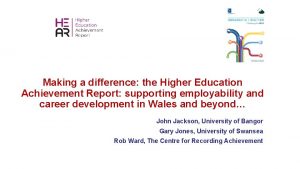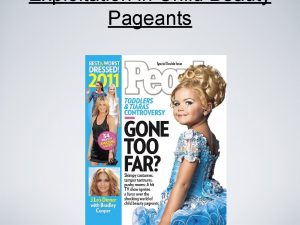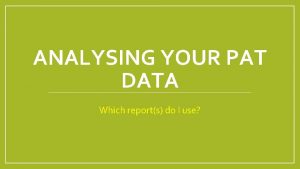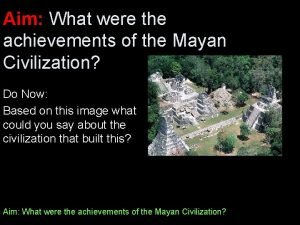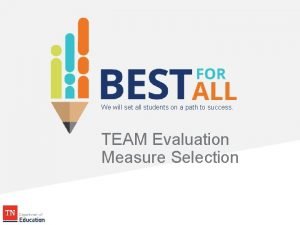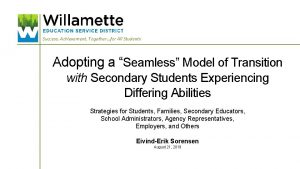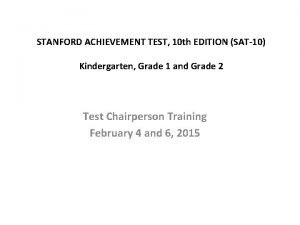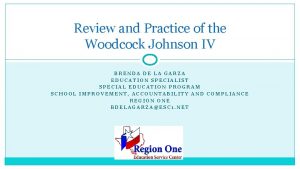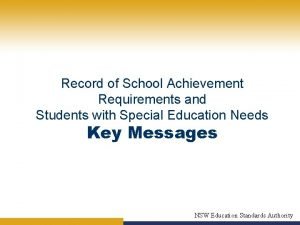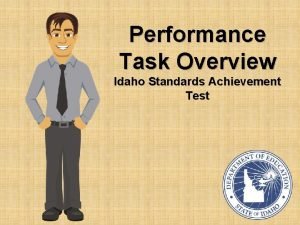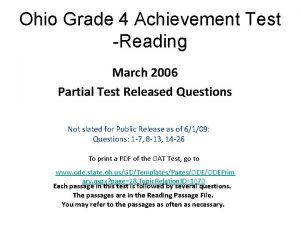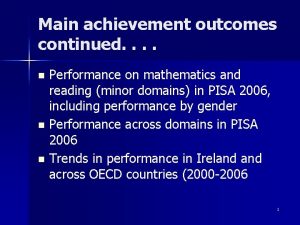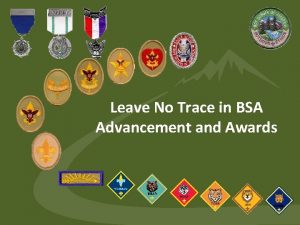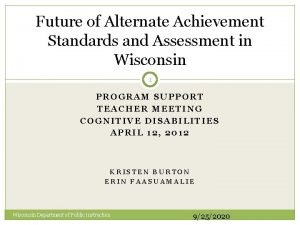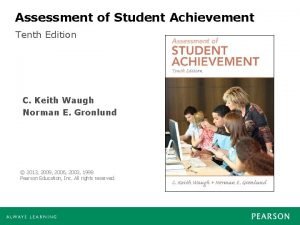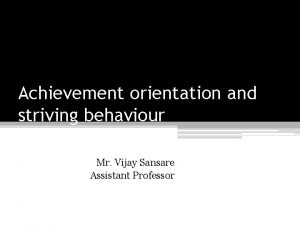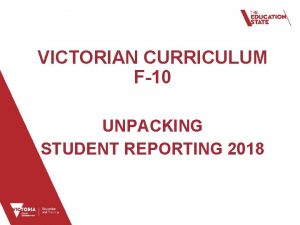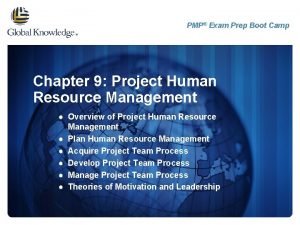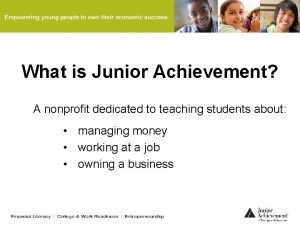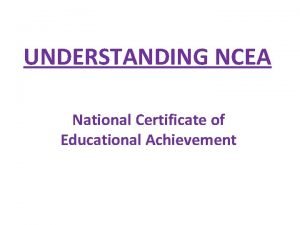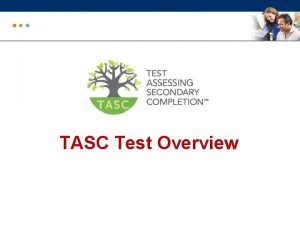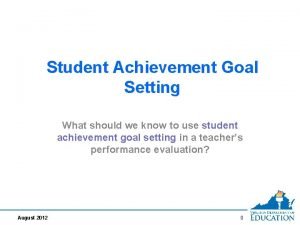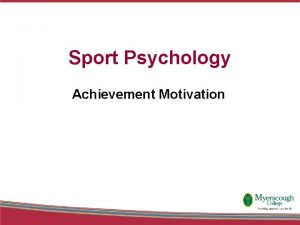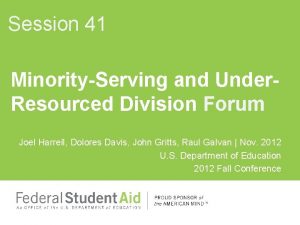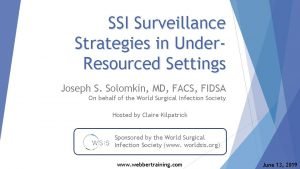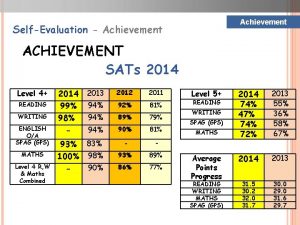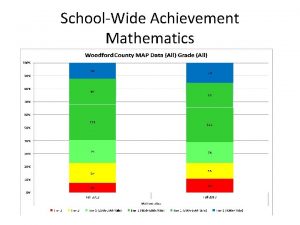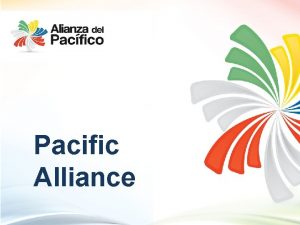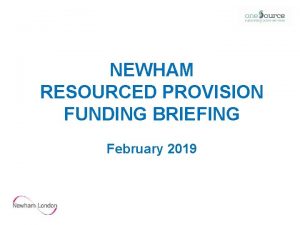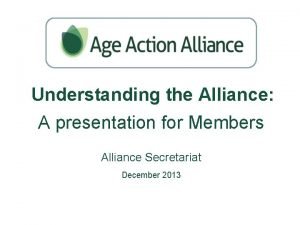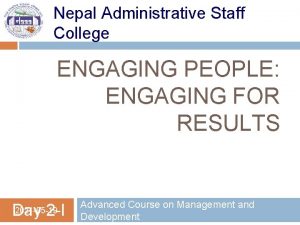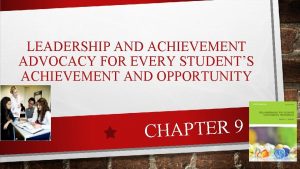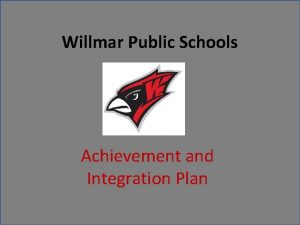College Achievement Alliance Understanding and Engaging Under Resourced






































































- Slides: 70

College Achievement Alliance Understanding and Engaging Under. Resourced College Students © 2017 by aha! Process, Inc. All rights reserved. www. ahaprocess. com 1

Introducing a systems approach: © 2017 by aha! Process, Inc. All rights reserved. www. ahaprocess. com 2

© 2017 by aha! Process, Inc. All rights reserved. www. ahaprocess. com 3

Mental Model of Poverty Tyranny of the Moment Concrete Unstable Arithmetic Doesn’t Work Problem Solving Developed by Phil De. Vol © 2017 by aha! Process, Inc. All rights reserved. www. ahaprocess. com 4

Mental Model of Middle Class Police Schools Religious organizations Social services Businesses Developed by Phil De. Vol Shopping/strip malls Bookstores Banks Fitness centers Veterinary clinics Office complexes Coffee shops Restaurants/bars Golf courses © 2017 by aha! Process, Inc. All rights reserved. www. ahaprocess. com 5

Mental Model of Wealth Developed by Ruby Payne © 2017 by aha! Process, Inc. All rights reserved. www. ahaprocess. com 6

Tyranny of the Moment “The need to act overwhelms any willingness people have to learn. ” –Peter Schwartz, The Art of the Long View “The trouble with being poor is that it takes up all your time. ” –Willem de Kooning, quoted in the Richmond, Virginia Times-Dispatch © 2017 by aha! Process, Inc. All rights reserved. www. ahaprocess. com 7

Key Point • This work is based on patterns. All patterns have exceptions. © 2017 by aha! Process, Inc. All rights reserved. www. ahaprocess. com 8

An individual’s resources are unique personal qualities gained from family, friends, communities, experiences, and the environment in general. Poverty can be defined as: “the extent to which an individual does without resources. ” © 2017 by aha! Process, Inc. All rights reserved. www. ahaprocess. com 9

Resources Knowledge of Hidden Rules Mental/Cognitive Emotional Motivation/Persistence Integrity/Trust Spiritual Language Relationships/Roles Models Support Systems Financial Physical © 2017 by aha! Process, Inc. All rights reserved. www. ahaprocess. com 10

Driving Forces Middle Income Poverty Survival Relationships Entertainment Middle class Wealth Work Political, financial, Achievement social connections Material Security © 2017 by aha! Process, Inc. All rights reserved. www. ahaprocess. com 11

Welcome to COLLEGE The Path to GRADUATION Starts Here © 2017 by aha! Process, Inc. All rights reserved. www. ahaprocess. com 12

Risk Factors Part-time attendance Working full-time Having dependent children Being a single parent Lacking external financial support Delaying enrollment after high school Having a GED (General Educational Development) diploma © 2017 by aha! Process, Inc. All rights reserved. www. ahaprocess. com 13

The Double Whammy: Student Dropout Rate After Completing First Year: 1995– 96 Public two-year Public four-year Private four-year For-profit Low-income and first- generation 32% 12% 26% Not low-income or first-generation 15% 4% 7% 18% Lederman, D. (2008, June 16). Double whammy of disadvantage. Inside Higher Ed. Retrieved from http: //www. insidehighered. com/news/2008/06/16/first © 2017 by aha! Process, Inc. All rights reserved. www. ahaprocess. com 14

What what? ? ? • Terms / semesters • First 15 hours transferable • Class / course • Probation /conditional • TAG ? C TAG • • Who does what? Recommendation letter Designated classes Tech Cert vs Associate Degree • TRANSLATION to parents? ? ? © 2017 by aha! Process, Inc. All rights reserved. www. ahaprocess. com 15

Under-represented groups in CCP Matrix 5: CCP Demographic Comparison Socioeconomic Status State CCP State % Disadvantaged 14. 3% 45. 0% Not Disadvantaged 39. 9% 55. 0% Unknown 45. 8% 0. 0% Race American Indian, Native American 0. 3% 0. 1% Asian, Pacific Islander 1. 7% 2. 1% African American 6. 3% 16. 0% Native Hawaiian 0. 1% Hispanic 2. 6% 4. 5% Multiple Races 1. 8% 4. 2% Unknown 15. 5% 0. 0% Caucasian, White 71. 6% 73. 0% © 2017 by aha! Process, Inc. All rights reserved. www. ahaprocess. com 16

Statistics are human beings with the tears wiped off. –Brodeur, 1985, p. 355 Brodeur, P. (1985). Outrageous misconduct: The asbestos industry on trial. New York, NY: Pantheon Books. © 2017 by aha! Process, Inc. All rights reserved. www. ahaprocess. com 17

The traditional expectation that students will mold themselves to the institution’s expectations and norms is simply too big a leap for too many students. –Understanding and Engaging Under-Resourced College Students, p. 161 Becker, K. A. , Krodel, K. M. , & Tucker, B. H. (2009). Understanding and engaging under-resourced college students: A fresh look at the influence of economic class on teaching and learning in higher education. Highlands, TX: aha! Process. © 2017 by aha! Process, Inc. All rights reserved. www. ahaprocess. com 18

Approach: Capitalize on Strengths and Remove Barriers Investigations into Economic Class in America Using the causes of poverty as a framework and economic class as a lens, students and faculty develop a new landscape within which to build knowledge, skills, relationships, and resources. © 2017 by aha! Process, Inc. All rights reserved. www. ahaprocess. com

Youngstown State University Learning Community Participants Returned Following Semester 100% 90% 88% 84% 75% 79% 73% 71% 72% 70% 60% Non-LCP 50% LCP 40% 30% 20% 10% 0% Fall 2009 Fall 2010 Fall 2011 Fall 2012 © 2017 by aha! Process, Inc. All rights reserved. www. ahaprocess. com 20

YSU Fall-to-Fall Retention Returned One Year Later 70% 63% 60% 53% 52% 50% 46% 48% 40% Non-LCP 30% 20% 10% 0% Fall 2009 Fall 2010 Fall 2011 © 2017 by aha! Process, Inc. All rights reserved. www. ahaprocess. com 21

Conditional Admission Status Youngstown State University Career Pathways Learning Community Investigations Not in Investigations Learning Community % released from conditional admission status after fall semester 77% 52% % remaining on conditional admission status 11% 26% % dismissed 11% 20% © 2017 by aha! Process, Inc. All rights reserved. www. ahaprocess. com 22

Getting Ahead Research © 2017 by aha! Process, Inc. All rights reserved. www. ahaprocess. com 23

Getting Ahead in a Just-Gettin’-By World: Program Evaluation Results Beth Wahler, Ph. D. , LSW © 2017 by aha! Process, Inc. All rights reserved. www. ahaprocess. com 24

Change in Scores: Full Sample Scale Name (Range of Potential Scores) Baseline Follow. Score Up Score Perceived Stress Scale (0– 52) Mental Health Continuum—Short Form 27. 7 Positive Affect Subscale (0– 15) Social Well-Being Subscale (0– 25) Psychological Well-Being Subscale (0– 30) State Hope Scale (6– 48) Agency Subscale (3– 24) Pathways Subscale (3– 24) General Self-Efficacy Scale (10– 40) Interpersonal Support Evaluation List Overall Functioning Poor Physical Health in Previous Month (0– 30) Days of Poor Mental Health in Previous Month (0– 30) # of Days Health Prevented Usual Activities (0– 30) 9. 8 11. 1 19. 6 10. 8*** 13. 2*** 21. 8*** 32. 9 37. 3*** 15. 6 17. 3 18. 4*** 18. 9*** 29. 5 31. 9*** Appraisal Support Subscale (0– 30) Tangible Support Subscale (0– 30) Self-Esteem Support Subscale (0– 30) Belonging Support Subscale (0– 30) 25. 2*** 17. 3 16. 6 17. 3 17. 8 19. 6*** 18. 6*** 19. 3*** 19. 8*** 8. 4 12. 8 7. 7 7. 3 9. 1*** 5. 5*** * = p ≤. 05, ** = p ≤. 01, *** = p ≤. 001 (significant changes are highlighted) © 2017 by aha! Process, Inc. All rights reserved. www. ahaprocess. com 25

University of Notre Dame Ines Jindra and Michael Jindra Connecting Poverty, Culture, and Cognition: The Bridges Out of Poverty Process Participant observation of participants for two years of attending Getting Ahead classes, trainings, meetings, and other activities. 39 graduates interviewed. Codes for perception of Getting Ahead, personal background, experiences with poverty, and progress after completion of Getting Ahead. Rated on how far they came in accomplishing the goals they set for themselves. 18 successful, 17 modestly successful, 4 unsuccessful. © 2017 by aha! Process, Inc. All rights reserved. www. ahaprocess. com 26

© 2017 by aha! Process, Inc. All rights reserved. www. ahaprocess. com 27

© 2017 by aha! Process, Inc. All rights reserved. www. ahaprocess. com 28

Key Point Poverty is relative. Economic class is a continuous line, not a clear-cut distinction. © 2017 by aha! Process, Inc. All rights reserved. www. ahaprocess. com 29

Key Point Generational poverty and situational poverty are different. © 2017 by aha! Process, Inc. All rights reserved. www. ahaprocess. com 30

Hidden Rules are the unspoken cues and habits of a group. © 2017 by aha! Process, Inc. All rights reserved. www. ahaprocess. com 31

Relationships can be broken when you do not know the hidden rules. Hidden rules can limit your interactions with people who are different from you. © 2017 by aha! Process, Inc. All rights reserved. www. ahaprocess. com 32

ROUTINES Content Protocol Classrooms Hidden Rules of College Culture Expectations TERMINOLOGY Stakeholders © 2017 by aha! Process, Inc. All rights reserved. www. ahaprocess. com 33

Hidden Rules in College Poverty Middle Class Driving force Relationships for survival. Entertainment. Achievement through work and education. Destiny Believes in fate. Cannot do much to mitigate chance. Believes in choice. Can change future with good choices now. Time Present survival most important. Future most important. Tyranny of the moment. Decisions made against future ramifications. Money To be spent. To be managed. Language Casual register, used for survival. Formal register, used for negotiation. Power Linked to personal respect, ability to fight. Power separated from respect, linked to information and institutions. © 2017 by aha! Process, Inc. All rights reserved. www. ahaprocess. com 34

Key Point Individuals bring with them the hidden rules of the class in which they were raised. © 2017 by aha! Process, Inc. All rights reserved. www. ahaprocess. com 35

Key Point For our students to be successful, we must understand their hidden rules and teach the rules that will make them successful in college, at work, and in the community. © 2017 by aha! Process, Inc. All rights reserved. www. ahaprocess. com 36

Mental/Cognitive Resources © 2017 by aha! Process, Inc. All rights reserved. www. ahaprocess. com 37

Question: Why do students from poverty tend to struggle academically more than their more affluent peers? © 2017 by aha! Process, Inc. All rights reserved. www. ahaprocess. com 38

Mediation: The foundation For designing courses/programs For choosing effective teaching strategies Stimulus Meaning Strategy (input) (elaboration) (output) © 2017 by aha! Process, Inc. All rights reserved. www. ahaprocess. com 39

Cognitive Skills INPUT: Quantity and Quality of Data Gathered 1. 2. 3. 4. 5. 6. Use planning behaviors. Focus perception on specific stimulus. Control impulsivity. Explore data systematically. Use appropriate and accurate labels. Organize space using stable systems of reference. 7. Orient data in time. 8. Identify constancies across variations. 9. Gather precise and accurate data. 10. Consider two sources of information at once. 11. Organize data (parts of a whole). 12. Visually transport data. ELABORATION: Efficient Use of Data 1. Identify and define the problem. 2. Select relevant cues. 3. Compare data. 4. Select appropriate categories of time. 5. Summarize data. 6. Project relationship of data. 7. Use logical data. 8. Test hypothesis. 9. Build inferences. 10. Make a plan using the data. 11. Use appropriate labels. 12. Use data systematically. OUTPUT: Communication of Elaboration and Input 1. Adapted from the work of Reuven Feuerstein. 2. 3. 4. Communicate clearly the labels and processes. Visually transport data correctly. Use precise and accurate language. Control impulsive behavior. © 2017 by aha! Process, Inc. All rights reserved. www. ahaprocess. com 40

Input: Quantity and Quality of Data Gathered 1. Use planning behaviors. 2. Focus perception on specific stimulus. 3. Control impulsivity. 4. Explore data systematically. 5. Use appropriate and accurate labels. 6. Organize space using stable systems of reference. 7. Orient data in time. 8. Identify constancies across variations. 9. Gather precise and accurate data. 10. Consider two sources of information at once. 11. Organize data (parts of a whole). 12. Visually transport data. © 2017 by aha! Process, Inc. All rights reserved. www. ahaprocess. com 41

Student Characteristics Resulting from Missing or Lacking Input, Elaboration, and Output Skills Classroom Behaviors That Demonstrate These Characteristics Input Phase Impairments concerning the quantity and quality of data gathered by the individual Blurred and sweeping perceptions Misses seeing salient features of an object or event Has difficulty concentrating Cannot relate parts of information to a whole structure © 2017 by aha! Process, Inc. All rights reserved. www. ahaprocess. com 42

Student Characteristics Resulting from Missing or Lacking Input, Elaboration, and Output Skills Classroom Behaviors That Demonstrate These Characteristics Input Phase Impairments concerning the quantity and quality of data gathered by the individual Unplanned, impulsive, and unsystematic exploratory behavior Do not care where they start or move to next in solving a problem Do not have a need to do things sequentially © 2017 by aha! Process, Inc. All rights reserved. www. ahaprocess. com 43

Strategies for Developing Input Skills Note Taking Time Management Planning Skills Organization Skills Mental Models © 2017 by aha! Process, Inc. All rights reserved. www. ahaprocess. com 44

Step Sheet Steps Amount of time 1. 2. 3. 4. 5. 6. 7. 8. 9. 10. 11. 12. © 2017 by aha! Process, Inc. All rights reserved. www. ahaprocess. com 45

CCP Application Deadline. Planning Steps Estimated time Target date Date assigned Deadline © 2017 by aha! Process, Inc. All rights reserved. www. ahaprocess. com 46

Knowledge Rating Scale Word Know it well Have seen or heard it rhombus x triangle x pentagon x quadrilateral x trapezoid square No clue x x © 2017 by aha! Process, Inc. All rights reserved. www. ahaprocess. com 47

Organizational Skills: Drilling Down © 2017 by aha! Process, Inc. All rights reserved. www. ahaprocess. com 48

Language © 2017 by aha! Process, Inc. All rights reserved. www. ahaprocess. com 49

Registers of Language Register Explanation Frozen Language that is always the same. For example: Lord’s Prayer, wedding vows, etc. Formal The standard sentence syntax and word choice of work and school. Has complete sentences and specific word choice. Consultative Formal register when used in conversation. Discourse pattern not quite as direct as formal register. Casual Language between friends, characterized by a 400 - to 800 -word vocabulary. Word choice general and not specific. Conversation dependent upon nonverbal assists. Sentence syntax often incomplete. Intimate Language between lovers or twins. Language of sexual harassment. Adapted from Martin Joos. © 2017 by aha! Process, Inc. All rights reserved. www. ahaprocess. com 50

Patterns of Discourse Formal Casual © 2017 by aha! Process, Inc. All rights reserved. www. ahaprocess. com 51

Story Structures Formal Casual © 2017 by aha! Process, Inc. All rights reserved. www. ahaprocess. com 52

Adult Adapted from work of Eric Berne. Child Parent Developing the Emotional Resource Through the Use of the Adult Voice Quit picking on me. You don't love me. You want me to leave. Nobody likes (loves) me. I hate you. You're ugly. You made me do it. You made me mad. She/he ______ did it. Don't blame me. It's your fault. You make me sick. You (shouldn't) should do that. It's wrong (right) to do ______. That's stupid, immature, out of line, ridiculous. Life's not fair. Get busy. You are good, bad, worthless, beautiful (any judgmental comment). You do as I say. If you weren't so ______, this wouldn't happen to you. Why can’t you be like ______? In what ways could this be resolved? What factors will be used to determine the effectiveness/quality of ______? I would like to recommend ______. What are choices in this situation? I am comfortable (uncomfortable) with ______. Options that could be considered are ______. For me to be comfortable, I need the following things to occur: ______. These are the consequences of that choice/action: ______. We agree to disagree. © 2017 by aha! Process, Inc. All rights reserved. www. ahaprocess. com 53

The Decontextualized Paper World of Middle Class For each of the items listed, what does the paper represent in the sensory world? Two examples are given. Abstract Item Grades/transcripts Represents The ticket to get into college, a better job, more money House deed Placement tests Syllabus Learning management platforms Email attachments The physical property Financial aid forms, scholarship applications Student handbook © 2017 by aha! Process, Inc. All rights reserved. www. ahaprocess. com 54

Relationships and Role Models © 2017 by aha! Process, Inc. All rights reserved. www. ahaprocess. com 55

“No significant learning occurs without a significant relationship. ” –Dr. James Comer © 2017 by aha! Process, Inc. All rights reserved. www. ahaprocess. com 56

Key Point #12 To build relationships of mutual respect, we must articulate clear and high expectations, insist that students will reach them even if they think they can’t, and provide appropriate support. © 2017 by aha! Process, Inc. All rights reserved. www. ahaprocess. com 57

Activity Mental Model of Social Capital © 2017 by aha! Process, Inc. All rights reserved. www. ahaprocess. com 58

Key Point In order to move from poverty to middle class or from middle class to wealth, an individual must give up relationships (at least for a time) for achievement. © 2017 by aha! Process, Inc. All rights reserved. www. ahaprocess. com 59

What Can Faculty and Staff Do to Build Relationships? • Provide individual help. • Ask questions to give student clues about answer. • Ask questions that require more thought. • Tell students whether their answers are right or wrong. • Give specific praise. • Give reasons for praise. Adapted from TESA (Teacher Expectations and Student Achievement), Los Angeles Department of Education. © 2017 by aha! Process, Inc. All rights reserved. www. ahaprocess. com 60

What Can Faculty and Staff Do to Build Relationships? (continued) Listen. Accept feelings of student. Get within arm’s reach of each student. Be courteous to students. Show personal interest and give compliments. Adapted from TESA (Teacher Expectations and Student Achievement), Los Angeles Department of Education. © 2017 by aha! Process, Inc. All rights reserved. www. ahaprocess. com 61

© 2017 by aha! Process, Inc. All rights reserved. www. ahaprocess. com 62

Righting Reflex vs. Psychological Reactance Colleges and programs often have a plan for the student before the student has acknowledged that a problem exists. Psychological reactance: “Don’t interfere with my rights, my freedom of choice!” Distrust of organizations. © 2017 by aha! Process, Inc. All rights reserved. www. ahaprocess. com 63

Motivation Goal: Develop cognitive dissonance. Illuminate the discrepancy between “what it’s like now” and the future story. Goal: The person makes the argument for change, not you. © 2017 by aha! Process, Inc. All rights reserved. www. ahaprocess. com 64

Begin by Listening “Research tells us that people are more likely to change when we reverse the flow of communication—that is, when people are not talked at but when they themselves have a chance to talk. ” –Richard Farson © 2017 by aha! Process, Inc. All rights reserved. www. ahaprocess. com 65

“If you have come to help me, you can go home again. But if you see my struggles as a part of your own survival, then perhaps we can work together. ” –Lila Watson, an Aboriginal Woman from Australia © 2017 by aha! Process, Inc. All rights reserved. www. ahaprocess. com 66

A Holistic Strategy for Institutions Capitalize on skills and learning styles. Bridge the gap in mindset and communication. Support success rather than sanction failure. Build relationships. Help colleges recognize and engage the gifts and abilities of all segments of society. Form productive partnerships. © 2017 by aha! Process, Inc. All rights reserved. www. ahaprocess. com 67

“Innovators are often not the principal agents of change; early adapters are. ” –Michael Fairbanks © 2017 by aha! Process, Inc. All rights reserved. www. ahaprocess. com 68

Postsecondary Community of Practice Allegany College, Cumberland MD Lower Columbia Community College, Longview, WA College of Saint Mary, Omaha, NE Madisonville Community College, Perdue, KY Cuyahoga Community College, Cleveland, OH Ohio Campus Compact, OH Danville Area Community College, Danville, IL Owens Community College, Toledo, OH Pillassippi State Community College, Frostburg University, Frostburg, Nashville, TN MD North Carolina State University, Gateway Technical College, Kenosha, WI Heidelberg University, Tiffin, Ohio Ivy Tech Community Colleges, IN Raleigh, NC Paul D. Camp Community College, Franklin, VA University of Oklahoma, Tulsa, OK Youngstown State University, Youngstown, OH Kent State University, Salem, Campus, Salem, OH © 2017 by aha! Process, Inc. All rights reserved. www. ahaprocess. com 69

www. collegeachievementalliance. com (800) 424 -9484 Karla Krodel kmkrodel@ysu. edu © 2017 by aha! Process, Inc. All rights reserved. www. ahaprocess. com 70
 Under resourced communities
Under resourced communities Occipito-posterior
Occipito-posterior Engaging dynamics
Engaging dynamics Marketing involve engaging directly with carefully targeted
Marketing involve engaging directly with carefully targeted Marketing involve engaging directly with carefully targeted
Marketing involve engaging directly with carefully targeted Kaufman test of educational achievement pros and cons
Kaufman test of educational achievement pros and cons Apa itu abilitas
Apa itu abilitas Ethnocentric curriculum
Ethnocentric curriculum Teaching excellence and achievement
Teaching excellence and achievement Wake tech admissions
Wake tech admissions Early college high school at midland college
Early college high school at midland college Woodcock-johnson iv scoring chart
Woodcock-johnson iv scoring chart Wrat-4
Wrat-4 Stanford 10 test
Stanford 10 test Industrial achievement performance model
Industrial achievement performance model Communicative achievement in writing
Communicative achievement in writing Provincial achievement tests
Provincial achievement tests Contoh identity foreclosure
Contoh identity foreclosure Self achievement adalah
Self achievement adalah Hse performance achievement template
Hse performance achievement template Peabody individual achievement test example
Peabody individual achievement test example Contoh tes performansi tipikal
Contoh tes performansi tipikal Kompetensi inti yang dihubungkan dengan strategi organisasi
Kompetensi inti yang dihubungkan dengan strategi organisasi Junior cycle profile of achievement
Junior cycle profile of achievement Picture arrangement test examples
Picture arrangement test examples Apa itu tes
Apa itu tes Growing success ontario
Growing success ontario Logo definisi
Logo definisi Task achievement scaling social work
Task achievement scaling social work Alfred binet ap psychology definition
Alfred binet ap psychology definition Virtuous achievement as a professional
Virtuous achievement as a professional Things not strings
Things not strings A desire for significant accomplishment
A desire for significant accomplishment Desire for high achievement
Desire for high achievement Wiat-ii
Wiat-ii Inclusive
Inclusive Sam reading inventory
Sam reading inventory Performance achievement hse
Performance achievement hse Higher education achievement report
Higher education achievement report Child beauty pageants history
Child beauty pageants history Pat 2016 report
Pat 2016 report Mayan civilization major achievements
Mayan civilization major achievements Achievement measure worksheet
Achievement measure worksheet Employment first
Employment first Stanford achievement test 10
Stanford achievement test 10 Woodcock johnson basal and ceiling examples
Woodcock johnson basal and ceiling examples Record of school achievement
Record of school achievement Idaho isat portal
Idaho isat portal Ohio achievement test
Ohio achievement test Achievement marketing
Achievement marketing Nnn achievement
Nnn achievement Bsa leave no trace
Bsa leave no trace Alabama alternate achievement standards
Alabama alternate achievement standards Fsa achievement level descriptors 2020
Fsa achievement level descriptors 2020 Why was the calendar an important egyptian achievement
Why was the calendar an important egyptian achievement To assess achievement at the end of instruction is
To assess achievement at the end of instruction is Strong achievement orientation
Strong achievement orientation Victorian curriculum achievement standards
Victorian curriculum achievement standards National certificate of educational achievement
National certificate of educational achievement Achievement of mkukuta
Achievement of mkukuta Pupil achievement
Pupil achievement Expectancy theory pmp
Expectancy theory pmp Certificate of achievement
Certificate of achievement American student achievement institute
American student achievement institute Junior achievement money moves song
Junior achievement money moves song National certificate of educational achievement
National certificate of educational achievement Tasc psychometrics made easy
Tasc psychometrics made easy Student achievement goals
Student achievement goals Sat 10 test
Sat 10 test Types of achievement test
Types of achievement test Naf sporting examples
Naf sporting examples
